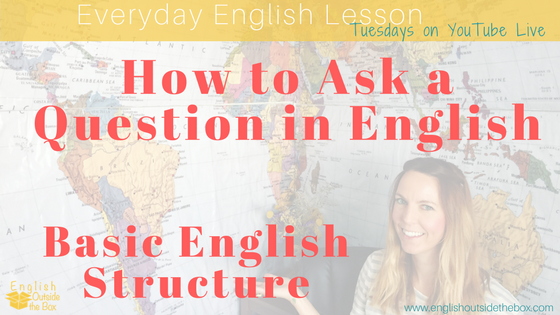
How to Ask Questions in English: Question Structure
There are many different types of questions in English, various ways to ask them, and questions are necessary for starting and maintaining English Conversations. How do you ask questions in English? What’s the correct question structure in English? Do auxiliary verbs go before or after the subject? What about tenses?
There are all kinds of doubts and confusions about English question structure, so I was not surprised when my Facebook group asked to learn more about them. I decided to make the rest of this month all about questions and make sure all of you are comfortable and confident with the basic foundation of questions in English. Today we’ll get back to the basics to begin.
In today’s “Everyday English” lesson, you’re going to learn:
- the basic structure of yes/no and information questions
- more about question words
- the difference between HOW and WHAT questions in greetings
- introduction to future lessons: embedded questions and subject VS object questions
Question Structure in English
There are two types of basic questions:
Yes/No Questions: the answers give simple yes or no responses
Information Questions: the answers provide more detail and information about something
Yes/No Question Structure:
Auxiliary + subject + main verb ( + extra information/details/adverbs, etc…)
Do you like cats?
Do we have more fruit?
Did you visit your family?
Will he eat lunch here?
Has she been to Paris?
Have you seen my friend?
*Notice that when the main verb is have (Do we have more fruit?), the auxiliary needs to be “do/does/did”
Information Question Structure:
Question word + auxiliary + subject + main verb ( + extra information….)
Where do you study English?
How is she doing today?
Why did you go to Europe?
When will we review embedded questions?
Who has he talked to about it?
What does she do for a living?
*Question words include: who, what, where, when, how, why, how much/many, how often, etc..
who – people, what – action/other details, where – place, when – time, how – manner, why – reason, how much/many – quantity, how often – frequency
HOW vs WHAT Questions
It’s common in greetings (saying hello) to ask a question to start a conversation. The most common questions for greetings that you’ve probably learned are: “How are you?” “What’s up?”
It’s important to know that HOW questions are asking about feelings and WHAT questions are asking about actions.
So you need to answer a HOW question (usually) with a form of the verb “to be” and an adjective, an adverb, or a general feeling.
How are you? How’s it going? How have you been? → I am good/tired/sad/bad/angry/well
In order to answer a WHAT question, you’ll need to talk about the action that you are doing or have been doing around that present time.
What’s up? What’s going on? What’s shaking? What’s happening? What have you been doing? → Nothing much/a lot/ I’ve been working/I am just studying lately/I am reading a book.
UPCOMING LESSONS:
embedded questions (and indirect questions): Can you tell me what time it is?
subject VS object questions: Who called you? VS Who did you call?
Practice Makes Perfect:
How many different types of questions can you make varying your time tenses and verbs? Are you confident creating a past perfect yes/no question? Can you create an information question with why in the present perfect progressive tense?
Try creating as many examples as you can following the structure pattern from this lesson.
Do you get stuck? If yes, this is where you need to start focusing more of your attention.
You can comment your examples below this blog or on YouTube, and definitely write any questions or doubts you have, too!
Also talked about in this lesson was tag questions. Read this lesson to practice more TAGS.
Until next time,
Happy Studying! ♥
As we’ve reviewed, understanding how to use questions is important for your overall fluency and English use. If you want to continue learning more natural English with me, with more focused materials, videos, audio, more PDFs, and group calls – then join my monthly training program, the Phrasal Verb Conversation Club. Learn more here:
The Conversation Club will provide you with 6 group conversation calls to practice with a real teacher and a group message community to connect with other members.
You will also get weekly English lessons to help your vocabulary, listening, reading, pronunciation, and more!
Try the Club for 1 week, free! Join the 1-week free trial here.

Is the question “What is an ambulance used for?” grammatically wrong?
No, especially not in conversational English.
Are the words interesting and interested related or different
[…] week in my Everyday English lesson on YouTube, I taught the basic structure of questions in English and the topic of embedded questions came up in the live chat. I decided to make the […]
Are the words interesting and interested related or different